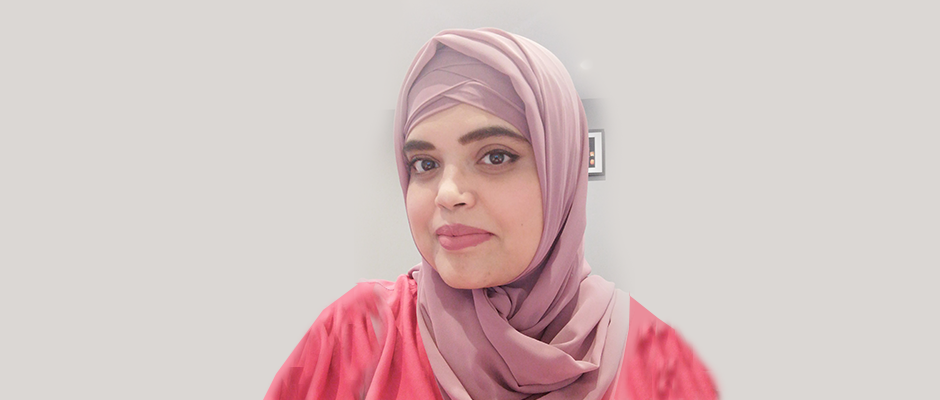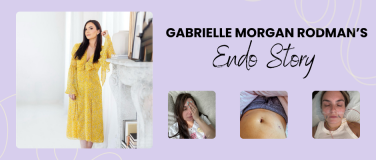
As a booklover and nerd, getting up for college everyday was one of my greatest joys some twenty years ago in the Mid-East. But I also felt a hidden worry on certain days around my period: that I would be too bloated and “felt heavy down below.” I would often ask my mum, “did you ever have to go through this feeling of pressure before your periods?” Most of the time, she’d reply, “no never.” Sometimes she said yes, and occasionally, “but never like yours.”
When I was a teenager, neither my mother nor I were curious to know what lay behind this pain and what could be a possible explanation. Those days, it was a social taboo to discuss these matters with unmarried, sexually-inactive girls, but I do recall eavesdropping on a conversation about a family friend’s teenage daughter missing college classes often, as she would “roll over with pain” during her period while her mom would be praying, crying, and putting hot packs on her tummy for relief. She had taken her daughter to quite a few “spiritual faith healers” back in Pakistan, yet no definite cure was attained. I was quite puzzled by her story and would feel sorry for her to have to pass through the horrid maze.
After getting into medical school and settling in Pakistan, I would often miss my period as a result of stress and an overload of work, but I would still have these “stony cramps” during my cycle, making me miss home more than ever before. Over a period of time, and thanks to the squat toilets in Pakistan, I started noticing that my urine stream was never straight—it always skewed to one side no matter how I adjusted my posture. I recall visiting a renowned gynecologist’s private clinic once, and when I presented my set of problems, I was disregarded and was told that as “nothing was wrong”; I should just drink fresh juices and exercise, “so as to improve the blood circulation.” I was not overweight, and while healthy lifestyle modifications are always welcome changes, I wasn’t satisfied with these conclusions. Doing pilates, yoga, and skipping rope regularly, as I had done most of my adolescent years, did take my mind away from these problematic days, and I would struggle between these pains and the everyday stressors of a hectic scheduled life.
Then came marriage and sexual activity—that opened up a new pandora’s box of issues. Though I conceived straight away (in the second month of my relationship), and delivered vaginally, I would get crampy periods more often. The painful intercourse was unbearable from the outset, and most of the time I would blame it on my copper IUD that had been in my womb for over three years (much to my disagreement and despite encountering frequent vaginal infections). I was a busy 24/7 O&G resident mom, yet deep inside I would be haunted by the days that would come every three weeks when I would just not be myself; when I would turn into an agonizing ball of pain who would drag herself out of bed and would avoid going to the toilet as long as possible—as using the bathroom, I knew, would simply hurt too much. The natural call had become a dreaded call, somehow, and the gripping pain that followed a bowel movement took all my strength away.
I remember having to take non-steroidals, such as Ibuprofen, to the bathroom so as to fight the agony as soon as it started; sometimes I took them even before going to the toilet in anticipation of the enemy. It was a near-normal for me to be late for work and to feel dull and timid all day during that time—until finally, my period would come and the tension would start releasing and washing away with the blood that I shed.
By that time I had understood it could be the “enigmatic endometriosis.” Yet, due to the never ending stressors in my life at that point, I kept my friends (NSAIDs) on me 24/7, and would pop one or two whenever I felt like the need arose. I would hit the gym twice a week and take Zumba classes to alleviate my mood. Despite all this, I had developed Grave’s disease by then, with critical free t4 levels, and was immediately diagnosed with a diffuse hyperactive thyroid gland on a thyroid scan. I still recall my endocrinologist being amazed by the fact that I was able to successfully ignore an enlarged goiter on my neck over the years (as I did with my other health issues). I even disregarded the intention tremors that I used to have as “muscle cramps.” We medics make such hopeless patients!
Until one day, it happened. I can still recall everything. It was a chilly afternoon in February, 2017; a sudden, gripping severe pain woke me up from my sleep and forced me into a projectile vomit. I nearly passed out, but I luckily had my mom around me and my five years old daughter. I was rushed immediately to the hospital in an ambulance and had a pelvic ultrasound done that revealed a right-sided 5x6 cm heterogenous hemorrhagic cyst and a smaller 2x2 cm left-sided cyst and some fluid in the pelvis. It was apparently an endometrioma that hadn’t torted at that point, but the dopplers couldn’t pick up good signal intensities due to the blood content. I was under the care of my fellow gynecologist colleague, a gynae-oncologist fresh from her Canadian fellowship, and she advised an urgent laparoscopy.
Despite my inclination to not pursue surgical interventions for myself, I simply couldn’t ignore the pain, pain that could have been detrimental to my survival if I didn’t have help by my side. I reluctantly consented to surgery. I was given time to go back home to get my stuff and hug my daughter and mom one last time before I fell into a deep sleep. My mother and daughter accompanied me to my room, where I was greeted and welcomed by my own friendly nursing staff, and then I was wheeled to the theater.
The operative story is something else entirely. What was supposed to be about an hour-long procedure was over five hours long due to the complexity of the case. My left ovary and tube were completely distorted by the endometrioma and dense adhesions tethered them to the pelvic side wall. A left salpingo-oopherectomy was performed and blood loss reached 700ml. A retroperitoneal ureterolysis and adhesinolysis had to be done in order to release the kinked ureter and dye test done to check ureteric integrity, which was luckily negative for any spills. Remarkably, the right side of my pelvis was reported to be normal, with multiple endometriotic spots on the pouch and ureter, giving it a Stage 3 classification.
I survived the anesthesia but came out quite groggy. I recall being able to hear the nurses handing me over as a status post left salipgooopherectomy, and soon after everything, I blacked out again. Recalling this detail was the last thing I wanted to hear regarding my operation. I recall being able to comprehend my surroundings the next morning when I saw my mom sitting by my side and smiling. It seemed like a new morning and I felt quite new, to say the least. The operative details carried little meaning then and I was relieved that I made it through. My consultant colleague came and briefed me about the findings and how lucky she thought I was to escape any ureteric injury or life saving hysterectomy as I had bled nearly a liter overall. She prescribed me OCPs to keep the spots quiescent, but because of some nasty headaches in the past that I had experienced with OCPs, I was reintroduced to my old friends, NSAIDs, again. Ever since this surgery, I haven’t had much of an encounter with them—though occasionally I do need their help. But the most remarkable outcome was my defecations becoming pain-free and my urine stream getting aligned. I had lost a considerable amount of weight since surgery, probably the water weight wearing off, and I have kept abreast with a healthy lifestyle.
My endometriosis surgery did wonders for me in many ways. I overcame my fear of surgical procedures (on myself) and underwent a total thyroidectomy the same year, as I had uncontrolled thyroid status on medical treatment and was avoiding radioactive treatment. I have remained sero-negative for any serum markers or antibodies, despite having autoimmune conditions like endometriosis, Grave’s disease and later, a diagnosis of fibromyalgia syndrome (FMS).
In 2019, I had suffered sudden bilateral greater trochanteric bursitis as well as gluteal medius tendonitis and was forced to be on crutches for a period of six months, during which I received steroid treatment and physiotherapy and had to keep working and travelling for exams and workshops. At one point, I thought it was my endometriosis that had woken up and somehow eroded my nerves to cause this kind of inflammatory cascade. As I expected, the pain was due to my FMS and corrective posture requirements.
I have decided to give a voice to this unheard plethora of pains and sufferings that women go through right from adolescence. Being a mother of a pre-teen daughter, I am very aware of educating the evolving mind to understand their bodies, ask questions, raise concerns and educate the natural processes, rather than misleading people due to societal taboos. Having a special interest in adolescent gynecology, I see pubertal or teenage girls coming into my clinic, quite puzzled, and not knowing how to address their fears or concerns. Their mothers, meanwhile, would be more concerned about their daughters’ school grades and the peer pressure around them. All this needs to change. We need our girls to know their bodies and what’s supposed to happen and what’s not supposed to happen. At a 1 in 10 frequency, endometriosis doesn’t seem to be improving much. We as women can do better for ourselves. We need to speak up from the very start, and more importantly, we need to be heard and listened to and provided psychological security and trust.
Dr. Aneela Ambareen, MBBS, MRCOG, DOWH, FACOG, has a special interest in women’s health and mental health issues. Currently working as specialist gynecologist in the NHS in London UK, she is keen on patient safety and preventive medicine.
Editor's note: Would you like to contribute to EndoStories? Click here to learn how to submit your work.
*Patient stories submitted to EndoFound.org are the views of the patient and not necessarily those of the foundation. All testimonials are from real patients, and may not reflect the typical patient’s experience, and are not intended to represent or guarantee that anyone will achieve the same or similar results.








